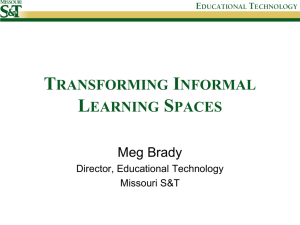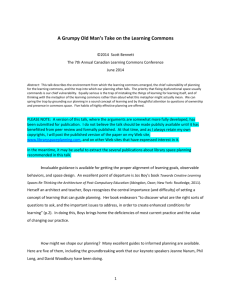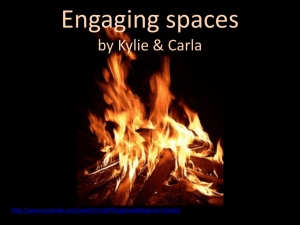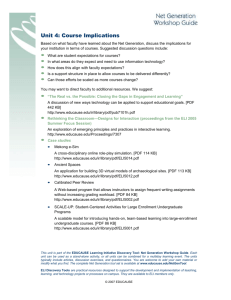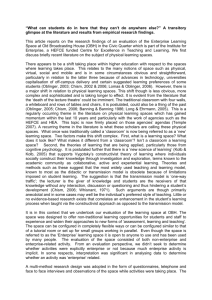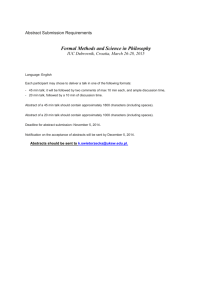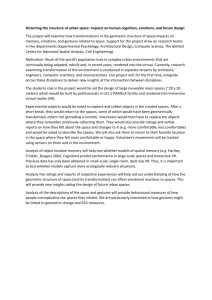Volume 1, Issue 1
advertisement
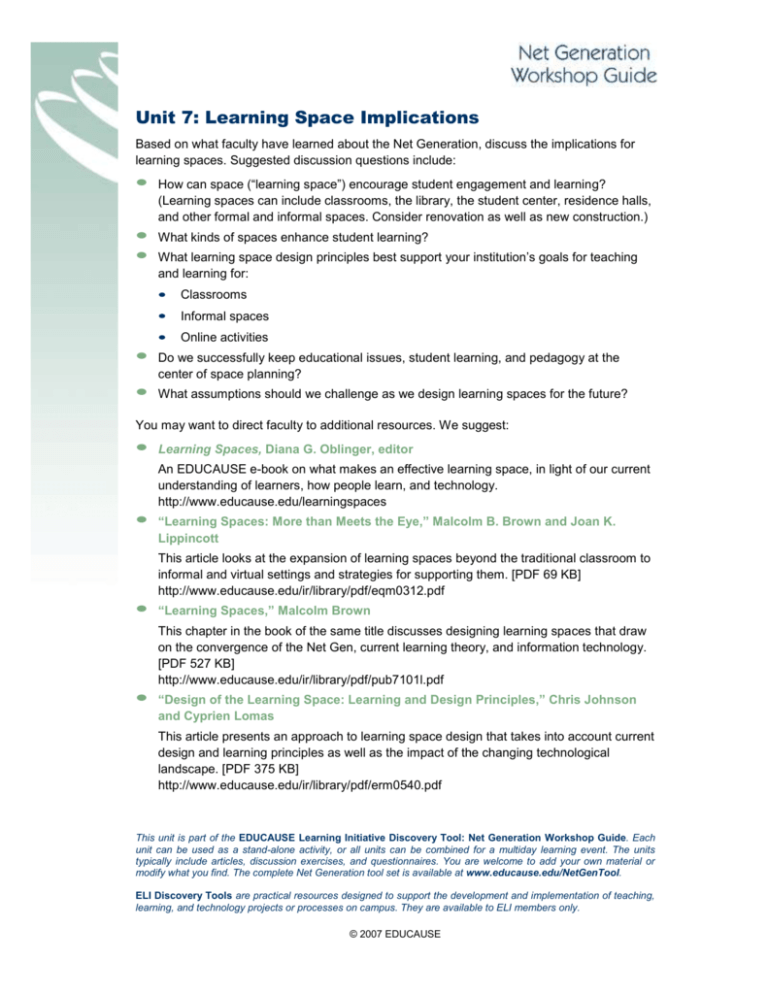
Unit 7: Learning Space Implications Based on what faculty have learned about the Net Generation, discuss the implications for learning spaces. Suggested discussion questions include: How can space (“learning space”) encourage student engagement and learning? (Learning spaces can include classrooms, the library, the student center, residence halls, and other formal and informal spaces. Consider renovation as well as new construction.) What kinds of spaces enhance student learning? What learning space design principles best support your institution’s goals for teaching and learning for: Classrooms Informal spaces Online activities Do we successfully keep educational issues, student learning, and pedagogy at the center of space planning? What assumptions should we challenge as we design learning spaces for the future? You may want to direct faculty to additional resources. We suggest: Learning Spaces, Diana G. Oblinger, editor An EDUCAUSE e-book on what makes an effective learning space, in light of our current understanding of learners, how people learn, and technology. http://www.educause.edu/learningspaces “Learning Spaces: More than Meets the Eye,” Malcolm B. Brown and Joan K. Lippincott This article looks at the expansion of learning spaces beyond the traditional classroom to informal and virtual settings and strategies for supporting them. [PDF 69 KB] http://www.educause.edu/ir/library/pdf/eqm0312.pdf “Learning Spaces,” Malcolm Brown This chapter in the book of the same title discusses designing learning spaces that draw on the convergence of the Net Gen, current learning theory, and information technology. [PDF 527 KB] http://www.educause.edu/ir/library/pdf/pub7101l.pdf “Design of the Learning Space: Learning and Design Principles,” Chris Johnson and Cyprien Lomas This article presents an approach to learning space design that takes into account current design and learning principles as well as the impact of the changing technological landscape. [PDF 375 KB] http://www.educause.edu/ir/library/pdf/erm0540.pdf This unit is part of the EDUCAUSE Learning Initiative Discovery Tool: Net Generation Workshop Guide. Each unit can be used as a stand-alone activity, or all units can be combined for a multiday learning event. The units typically include articles, discussion exercises, and questionnaires. You are welcome to add your own material or modify what you find. The complete Net Generation tool set is available at www.educause.edu/NetGenTool. ELI Discovery Tools are practical resources designed to support the development and implementation of teaching, learning, and technology projects or processes on campus. They are available to ELI members only. © 2007 EDUCAUSE Unit 7 “Creation of the Learning Space: Catalysts for Envisioning and Navigating the Design Process,” Carole C. Wedge and Thomas D. Kearns This article discusses the practical steps involved in the learning space planning and design process. [PDF 319 KB] http://www.educause.edu/ir/library/pdf/erm0541.pdf “Future of the Learning Space: Breaking Out of the Box,” Phillip D. Long and Stephen C. Ehrmann This article presents an approach to learning space design that takes into account current design and learning principles as well as the impact of the changing technological landscape. [PDF 643 KB] http://www.educause.edu/ir/library/pdf/erm0542.pdf As faculty review these resources, ask them to make notes about the following questions. Use this as the basis for group discussions and planning. Questions Notes What key points are you taking away from these resources? What ideas best apply to your situation? As a result of the key concepts you have identified, what will you do differently? Follow-up After you have completed this activity you may find it beneficial to ask participants for feedback. Some suggested questions are: Do you feel you now better understand how Net Gen learners interact with the environment around them? Has the activity prompted you to think differently about the nature of learning spaces? Has it given you ideas for new approaches to the design of learning spaces at your institution? Did you find this activity a valuable use of your time? What could we do to make this activity more effective? 2
